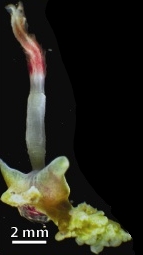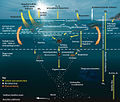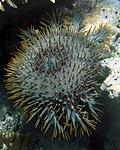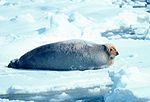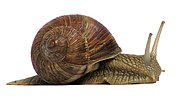Search results
Appearance
The page "Polychaete+Hypothesis" does not exist. You can create a draft and submit it for review or request that a redirect be created, but consider checking the search results below to see whether the topic is already covered.
- economically important parasite of salmonids, has been shown to use a polychaete worm as an alternate host. Direct transmission between fish has also been...6 KB (692 words) - 02:27, 23 June 2024
- for locomotion. Most textbooks still use the traditional division into polychaetes (almost all marine), oligochaetes (which include earthworms) and leech-like...89 KB (9,020 words) - 18:35, 4 August 2024
- Articulata hypothesis was born. The Articulata hypothesis, simply stated, is the phylogenetic grouping of the phylum Annelida (which includes polychaetes, oligochaetes...10 KB (1,014 words) - 13:23, 6 November 2023
- temperature strange and seemingly hard to maintain. The current hypothesis is that the polychaete worm maintains an “external microenvironment” that does not...22 KB (2,706 words) - 02:56, 12 May 2024
- Chaetopterus (category Polychaete genera)Chaetopterus or the parchment worm or parchment tube worm is a genus of marine polychaete worm that lives in a tube it constructs in sediments or attaches to a...7 KB (823 words) - 22:31, 5 December 2023
- Osedax is a genus of deep-sea siboglinid polychaetes, commonly called boneworms, zombie worms, or bone-eating worms. Osedax is Latin for "bone-eater"...35 KB (4,104 words) - 00:23, 17 June 2024
- Tomopteris, a holoplanktic polychaete worm with an unusual yellow bioluminescence that emanates from its parapodia...5 KB (512 words) - 21:04, 23 June 2021
- Earth. Coacervate-like protocells are at the core of the Oparin-Haldane hypothesis. A reawakening of coacervate research was seen in the 2000s, starting...29 KB (3,645 words) - 12:37, 29 May 2024
- Biological pump (redirect from Bioluminescent shunt hypothesis)correlated in the bathypelagic zones of the ocean. This has led to the hypothesis that organic carbon export is determined by the presence of ballast minerals...145 KB (16,337 words) - 10:20, 2 June 2024
- (applied experimentally, from posterior). Along with other species of polychaete worms, S. insignis is host to kleptoparasitic suspension-feeding snails...4 KB (521 words) - 01:56, 19 December 2023
- Eunicidae (category Polychaetes)Eunicidae is a family of marine polychaetes (bristle worms). The family comprises marine annelids distributed in diverse benthic habitats across Oceania...29 KB (3,001 words) - 14:11, 22 May 2024
- and some other corals may also be due to resident bivalve mollusks and polychaete worms in the surface of the coral, which discourage the starfish. Similarly...76 KB (9,711 words) - 21:35, 9 July 2024
- the dominant bioturbators are small invertebrates, such as earthworms, polychaetes, ghost shrimp, mud shrimp, and midge larvae. The activities of these...62 KB (7,536 words) - 10:38, 2 June 2024
- more likely to be a stem group polychaete worm, in other words an evolutionary "aunt" or "cousin" of more recent polychaetes. This interpretation is reinforced...28 KB (2,777 words) - 19:34, 7 July 2024
- In evolutionary developmental biology, inversion refers to the hypothesis that during the course of animal evolution, the structures along the dorsoventral...16 KB (1,822 words) - 17:34, 22 February 2024
- Cartilage (section Sabellid polychaetes)such as marine snails and cephalopods, and some annelids like sabellid polychaetes. The most studied cartilage in arthropods is the branchial cartilage...34 KB (3,824 words) - 06:19, 27 July 2024
- and fungi) as well as larger invertebrates, such as crustaceans and polychaetes. Organisms here generally live in close relationship with the substrate...20 KB (2,466 words) - 17:03, 1 June 2024
- sea stars, sea cucumbers, fiddler crabs, and some sedentary marine Polychaetes such as worms of the family Terebellidae. Detritivores can be classified...10 KB (980 words) - 18:23, 19 July 2024
- been found to feed on invertebrates such as anemones, sea cucumbers, and polychaete worms. The same study found that sculpins and Arctic cod made up most...23 KB (2,698 words) - 15:31, 22 July 2024
- feeding apparatus was a type of radula or more similar to that of some polychaete worms. Nicholas Butterfield, who opposes the idea that Wiwaxia was a mollusc...94 KB (9,576 words) - 09:17, 5 August 2024
- plainly separable and represent the extremes of Polychaete organization, (1) Nereidiformia.—“Errant” Polychaetes with well-marked prostomium possessing tentacles
- Fauchald, Kristian, and Peter A. Jumars. "The Diet of Worms: a Study of Polychaete Feeding Guilds." Oceanogr. Mar. Biol. Ann. Rev. 17 (1979): 193-284. ^






